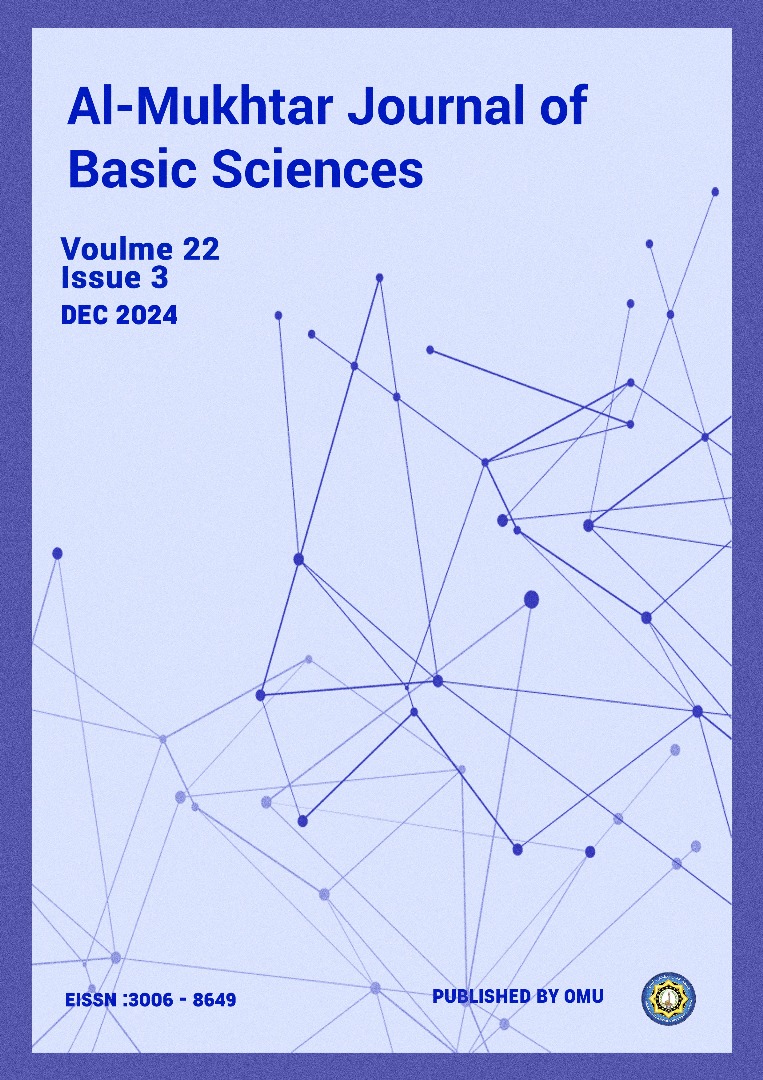Chemical composition of Ocimum sanctum by GC-MS Analysis
DOI:
https://doi.org/10.54172/tr3mwd31Keywords:
Ocimum sanctum, GCAbstract
The chemical composition of the n-hexane extract from the aerial parts of Ocimum sanctum., was investigated using gas chromatography-mass spectrometry (GC/MS), identifying 46 different compounds. Terpenoids were the most abundant, with monoterpenes representing 21.82% of the extract. The primary components identified were methyl eugenol (27.24%), squalene (11.84%) α-bergamotene (9.83%), linalool (8.42%), and fenchyl acetate (7.56%). These results indicate that O. sanctum could serve as a valuable source of food and medicinal agents.
References
Desai, K., Wei, H., & Lamartiniere, C. (1996). The preventive and therapeutic potential of the squalene-containing compound, Roidex, on tumor promotion and regression. Cancer letters, 101(1), 93-96.
EL-Kamali, H. H., & EL-Amir, M. Y. (2010). Antibacterial activity and phytochemical screening of ethanolic extracts obtained from selected Sudanese medicinal plants. Current Research Journal of Biological Sciences, 2(2), 143-146.
Hassanpouraghdam, M. B., Hassani, A., & Shalamzari, M. S. (2010). Menthone-and estragole-rich essential oil of cultivated Ocimum basilicum L. from Northwest Iran. Chemija, 21(1), 59-62.
Hosseinzadeh, S., Jafarikukhdan, A., Hosseini, A., & Armand, R. (2015). The application of medicinal plants in traditional and modern medicine: a review of Thymus vulgaris. International Journal of Clinical Medicine, 6(9), 635-642.
Jirovetz, L., Buchbauer, G., Stoyanova, A., & Balinova, A. (2001). Analysis, chemotype and quality control of the essential oil of a new cultivated basil (Ocimum basilicum L.) plant from Bulgaria. Scientia Pharmaceutica, 69(1), 85-89.
Khair-ul-Bariyah, S. (2013). Comparison of the Physical Characteristics and GC/MS of the Essential Oils of Ocimum basilicum and Ocimum sanctum. International Journal of Scientific Research in Knowledge, 1(9), 363.
Kohno, Y., Egawa, Y., Itoh, S., Nagaoka, S.-i., Takahashi, M., & Mukai, K. (1995). Kinetic study of quenching reaction of singlet oxygen and scavenging reaction of free radical by squalene in n-butanol. Biochimica et Biophysica Acta (BBA)-Lipids and Lipid Metabolism, 1256(1), 52-56.
Mondello, L., Zappia, G., Cotroneo, A., Bonaccorsi, I., Chowdhury, J. U., Yusuf, M., & Dugo, G. (2002). Studies on the essential oil‐bearing plants of Bangladesh. Part VIII. Composition of some Ocimum oils O. basilicum L. var. purpurascens; O. sanctum L. green; O. sanctum L. purple; O. americanum L., citral type; O. americanum L., camphor type. Flavour and fragrance journal, 17(5), 335-340.
Mustafa, A. A., & El-kamali, H. H. (2019). Chemical composition of Ocimum americanum in Sudan. Res. Pharm. Health Sci, 5(3), 172-178.
Mustafa, A. A., & El-kamali, H. H. (2020). Proximate and phytochemical constituents of in Sudan Ocimum sanctum.
Nahak, G., Mishra, R., & Sahu, R. (2011). Taxonomic distribution, medicinal properties and drug development potentiality of Ocimum (Tulsi). Drug Invention Today, 3(6).
Omer, H. A., Mustafa, A. A., Kabbashi, A. S., & Taher, A. R. (2024). Antimicrobial, Antioxidant Activities and total phenolics contents of Portulaca oleracea., crude extracts, Sudan.
Park, I.-K., Kim, J., Lee, S.-G., & Shin, S.-C. (2007). Nematicidal activity of plant essential oils and components from ajowan (Trachyspermum ammi), allspice (Pimenta dioica) and litsea (Litsea cubeba) essential oils against pine wood nematode (Bursaphelenchus xylophilus). Journal of nematology, 39(3), 275.
Periyasamy Ashokkumar, P. A., Rajkumar, R., & Mahalingam Kanimozhi, M. K. (2010). Phytochemical screening and antimicrobial activity from five Indian medicinal plants against human pathogens.
Sabogal-Guáqueta, A. M., Osorio, E., & Cardona-Gómez, G. P. (2016). Linalool reverses neuropathological and behavioral impairments in old triple transgenic Alzheimer's mice. Neuropharmacology, 102, 111-120.
Sahreen, S., Khan, M. R., Khan, R. A., & Hadda, T. B. (2015). Evaluation of phytochemical content, antimicrobial, cytotoxic and antitumor activities of extract from Rumex hastatus D. Don roots. BMC complementary and alternative medicine, 15, 1-6.
Saint-Leger, S., Bague, A., Cohen, E., & Chivot, M. (1986). A possible role for squalene in the pathogenesis of acne. I. In vitro study of squalene oxidation. II. In vivo study of squalene oxides in skin surface and intra-comedonal lipids of acne patients.
Sfara, V., Zerba, E., & Alzogaray, R. A. (2009). Fumigant insecticidal activity and repellent effect of five essential oils and seven monoterpenes on first-instar nymphs of Rhodnius prolixus. Journal of medical entomology, 46(3), 511-515.
Yano, K. (1987). Minor components from growing buds of Artemisia capillaris that act as insect antifeedants. Journal of Agricultural and Food Chemistry, 35(6), 889-891.
Downloads
Published
Issue
Section
License
Copyright (c) 2024 Ahmed A. Mustafa, Mubarak S. Hamad, Haifa A. Awad, Hatil El-kamali (Author)

This work is licensed under a Creative Commons Attribution-NonCommercial 4.0 International License.
Copyright of the articles Published by Al-Mukhtar Journal of Basic Sciences (MJBS) is retained by the author(s), who grant MJBS a license to publish the article. Authors also grant any third party the right to use the article freely as long as its integrity is maintained and its original authors and cite MJSc as the original publisher. Also, they accept the article remains published by the MJBS website (except in the occasion of a retraction of the article).












